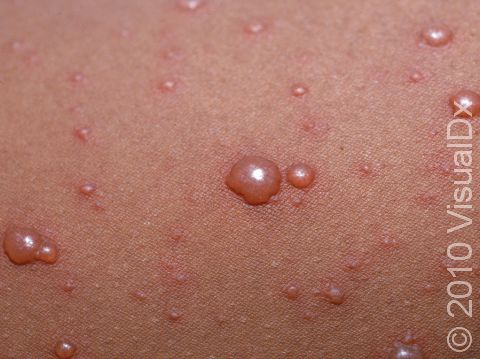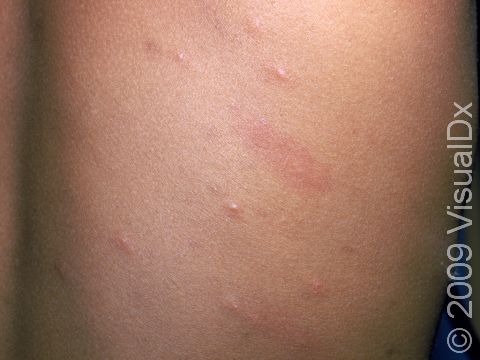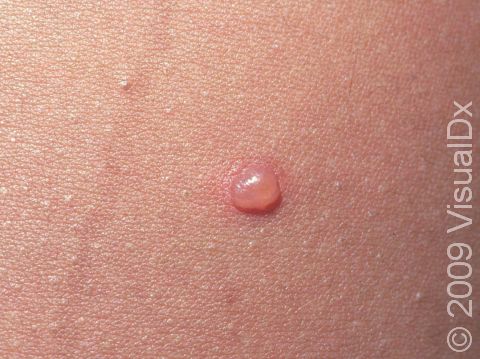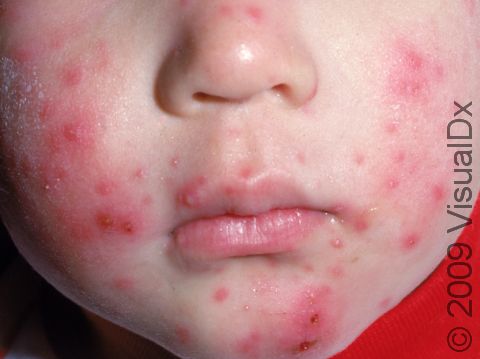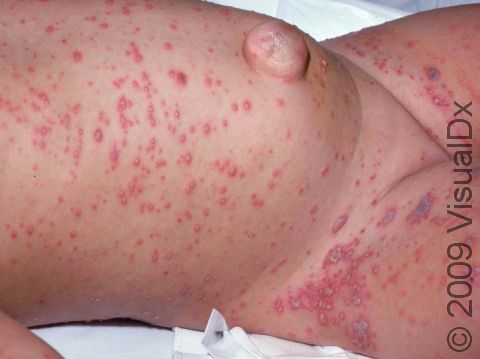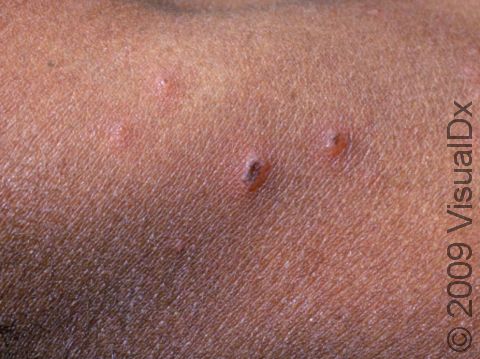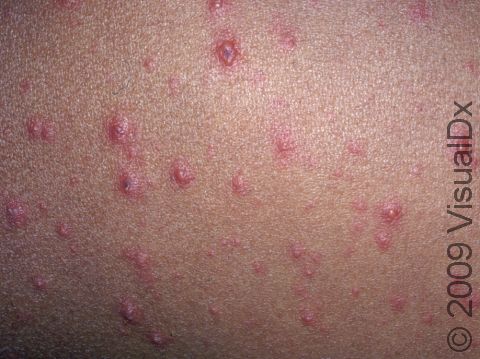Chickenpox (Varicella)
Chickenpox (varicella) is a rare infection, which is extremely serious in infants, caused by a virus of the herpes family. Infants who are infected are either infected because their mothers were infected during pregnancy (fetal or congenital varicella) or acquired the virus after they were born (postnatal varicella). Fetal varicella and congenital varicella are much more serious forms of this disease, and there is a high risk of malformations and death to the newborn. Postnatal varicella is less severe, and infants typically only have the classic chickenpox rash. This rash appears as tiny itchy, flat, red spots on the skin that raise into clear fluid-filled blisters that eventually crust over. A fever, headache, and occasional stomach pain may also be present with the rash. The rash usually first appears on the scalp, face, or chest and tends to be more prominent in the center of the body.
People with chickenpox are contagious from 24–48 hours prior to the appearance of the rash and continue to be contagious up until a week after the onset of the rash. This disease is spread by respiratory secretions, such as from mucus or saliva, so it is especially important to keep unimmunized children and infants away from infected persons.
Who's At Risk?
Chickenpox is not as common as it once was due to the varicella vaccine. However, some children that are immunized may still get a milder form of chickenpox. It is most common in children under the age of 10. This disease is rare in infants, as they are usually protected by their mother’s immune system (unless their mother was never infected or vaccinated).
Signs & Symptoms
Most children with chickenpox act sick with fever and vague symptoms (loss of appetite, headache, belly ache) for 1–2 days before they start to break out with a rash. These symptoms last for 2–4 days after the rash appears.
An early pink-to-red, flat, small spot rapidly becomes bumpy and then blisters with a surrounding halo of redness. The spots usually appear first on the trunk or scalp. Linings of body cavities, such as the mouth or nose (mucous membranes), palms, and soles, can also have a few lesions. The average child develops a few hundred blisters, most of which heal without leaving scars. A child who has had the chickenpox vaccine will have far fewer lesions.
The blister typical of chickenpox is usually described as looking like a dewdrop on a rose petal. The blister area (vesicle) is thin-walled and easily broken. Vesicles become cloudy and then crust over, with healing completed within 1–3 weeks. Chickenpox lesions often occur in three or more successive series (crops). Lesions in different stages of development may occur at the same time.
Self-Care Guidelines
Since the illness resolves on its own after 1–3 weeks, it is most important to keep the child comfortable and to discourage scratching, which can cause infection and scars.
For itching:
- Oatmeal baths in lukewarm water
- Oral antihistamines (diphenhydramine, chlorpheniramine)
- Clip the child’s fingernails
- Apply calamine lotion
- DO NOT USE lotions containing antihistamines or lidocaine, as they are no more effective than the previous measures and might cause allergic reactions later on.
For pain and fever:
- Use acetaminophen (eg, Tylenol).
- DO NOT USE aspirin in children aged 18 years or younger, as the use of aspirin in children with chickenpox has been associated with Reye syndrome, a severe disease.
- The American Academy of Pediatrics recommends AVOIDING treatment with ibuprofen (eg, Advil) if possible because it has been associated with life-threatening bacterial skin infections.
Because chickenpox is highly contagious, keep the child at home and resting until symptoms are gone and all blisters have dried up. Avoid any contact between your child and pregnant women who have never had chickenpox, newborns, or people who have a weak immune system or eczema. Once all the blisters have dried into scabs, the child is not considered contagious to others.
Treatments
Antiviral medication may be given if the child with chickenpox is seen early (during the first day of the rash) or for children at higher risk for more severe disease (those with asthma, eczema, recent sunburn, children taking corticosteroids on a regular basis, and those with weak immune systems).
Visit Urgency
Most chickenpox infections do not require treatment.
If there are adults or teens in the household who have never had chickenpox or people with eczema, asthma, or a weakened immune system, have them contact their doctor, as they may require antiviral medication. This usually needs to be done early (during the first day of the rash).
Call your child’s doctor if you suspect the child has chickenpox and:
- The child has eczema, asthma, or a weakened immune system.
- The fever lasts more than 4 days or exceeds 102 degrees Fahrenheit.
- Any rash areas look red, swollen, and leak pus.
- The child has a severe cough, vomiting, headache, drowsiness, confusion, stiff
neck, trouble looking at bright lights, or difficulty walking or breathing.
References
Bolognia, Jean L., ed. Dermatology, pp.1241-1243. New York: Mosby, 2003.
Freedberg, Irwin M., ed. Fitzpatrick’s Dermatology in General Medicine. 6th ed. pp.2070, 2080-2081, 2434-2437. New York: McGraw-Hill, 2003.
Last modified on April 5th, 2023 at 9:03 am

Not sure what to look for?
Try our new Rash and Skin Condition Finder
